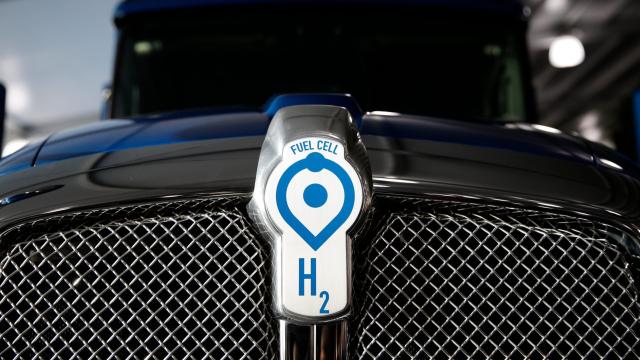New research finds that blue hydrogen, touted by fossil fuel producers as a climate solution, actually has a 20% larger greenhouse gas footprint than just using natural gas. The study, published Thursday in Energy Science & Engineering, gives some important context on a much-hyped new fuel, one that happens to be the “clean energy” apple of the fossil fuel industry’s eye.
Hydrogen, the most common element in the universe, has a lot of promise for the energy transition: it can power cars, provide electricity to buildings, and be used to help decarbonise tough industries like manufacturing and construction. The problem with hydrogen is that it needs to be separated from other elements, which in and of itself takes a lot of energy. Hydrogen can be separated from oxygen in water via electrolysis to create what’s known as green hydrogen — an option free from any greenhouse gas emissions, but one that’s pretty expensive. It can also be harvested from fossil fuels like coal and gas, to create what’s known as grey hydrogen. This is a little cheaper than green hydrogen, but emits quite a lot of CO2 during the hydrogen extraction process.
Faced with growing calls to decarbonise — as well as a big supply of natural gas that they needed to find uses for — fossil fuel producers came up with the idea of repackaging the image of grey hydrogen as low-carbon by capturing all the carbon emissions that would come with its creation. A new type of hydrogen was born: blue hydrogen, which is grey hydrogen that uses carbon capture and storage technology to get rid of all those pesky carbon emissions and be, technically, a lower-carbon fuel. Big Oil saw the opportunity to use blue hydrogen as part of their public relations push for a lower-carbon future.
“As far as I can tell, no one was talking about blue hydrogen until just a few years ago,” study author Robert Howarth said in an email. “The Hydrogen Council was established in 2017 by BP, Shell, and Total, and they and other industry-related groups started pushing this blue hydrogen idea hard. They described [blue hydrogen] as low emissions, or sometimes zero emissions. But they never presented real data to back that up.” Until this paper, Howarth said, there hasn’t been any peer-reviewed effort to analyse the greenhouse gas footprint of blue hydrogen — just “industry summaries” that he said “do not hold up well to close scrutiny.”
Unfortunately for the oil and gas industry, closely looking at the creation process of blue hydrogen uncovers some uncomfortable truths. Howarth’s study found that blue hydrogen has only a slightly lower carbon footprint than grey hydrogen — and, in terms of methane, the picture is a lot worse.
“While CO2 emissions are less for blue than for grey hydrogen, methane emissions are greater,” Howarth said. “That is because more natural gas is consumed to make the blue hydrogen, as energy is needed to power the CO2 capture, and this energy comes from natural gas.”
Methane emissions only stay in the atmosphere for a little over a decade, far shorter than carbon dioxide’s 300-to-1,000-year lifespan — but they pack quite a punch while they’re there, as methane is around 80 times more potent than carbon dioxide. The IPCC report released this week for the first time called out methane as a big climate problem, finding that methane emissions have risen drastically over the past decade. Chief among the methane culprits are oil and gas companies, which release a lot of methane in the process of extracting natural gas. The IPCC estimates that fossil fuel companies were responsible for a quarter of global methane emissions.
The methane findings in the IPCC report are especially worrisome when considering what a natural-gas-heavy process creating hydrogen from fossil fuel and storing the CO2 emissions is. In fact, making the hydrogen is so energy-intensive that blue hydrogen’s greenhouse gas footprint is bigger than that of natural gas. In other words, burning this supposed “clean” fuel actually is worse, greenhouse gas-wise, than just using natural gas itself.
“It takes a large amount of natural gas to make hydrogen, using the methane in the gas as the feedstock source, but also to burn it to power the steam-reforming process and the CO2 capture process,” Howarth said. “There are emissions of both CO2 and methane associated with this large use of gas.”
There’s a lot of hype around the possibilities of hydrogen right now, as governments and industries around the world look to decarbonise. The infrastructure bill that passed the Senate Wednesday included $US8 ($11) billion earmarked for hydrogen energy development; Department of Energy officials have talked in the past about how blue hydrogen can fit into the Biden administration’s clean energy goals. The hydrogen industry said in February that more than 30 countries have created plans around developing more hydrogen projects. The UK is developing a hydrogen strategy of its own, and a government official told the Guardian that hydrogen would be “essential” to the UK’s own climate goals.
“We need to move away from all fossil fuels as soon as possible,” Howarth said. “The best way to do that is with 100% renewable electricity from solar, wind, and hydro sources, combined with beneficial electrification to provide heat from high-efficiency heat pumps and to provide transportation from electric vehicles. Blue hydrogen is a dangerous distraction, which, if actually employed at scale, would aggravate rather than help address climate change. Policy makers should be sceptical of such ideas until they are thoroughly vetted by independent full lifecycle analysis by scientists and engineers in a transparent and peer-reviewed framework.”
